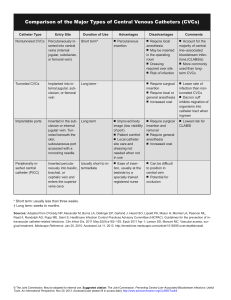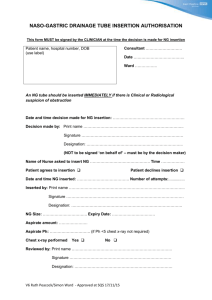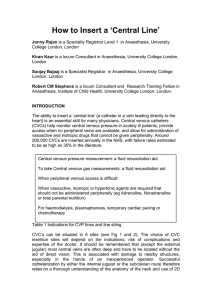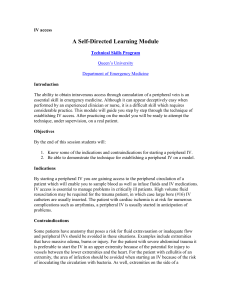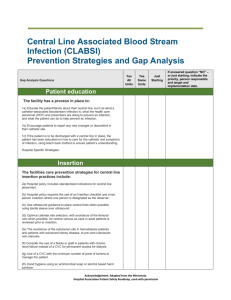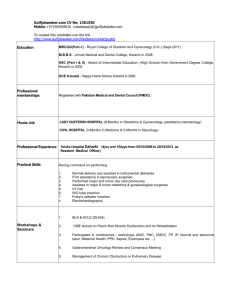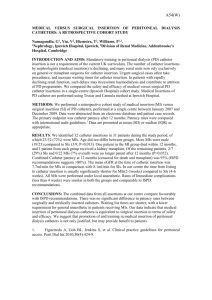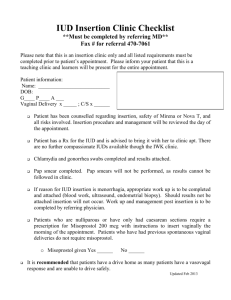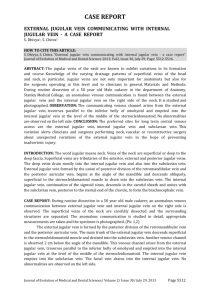ExternalJugularPolicy - Emergency Nurses Association
advertisement
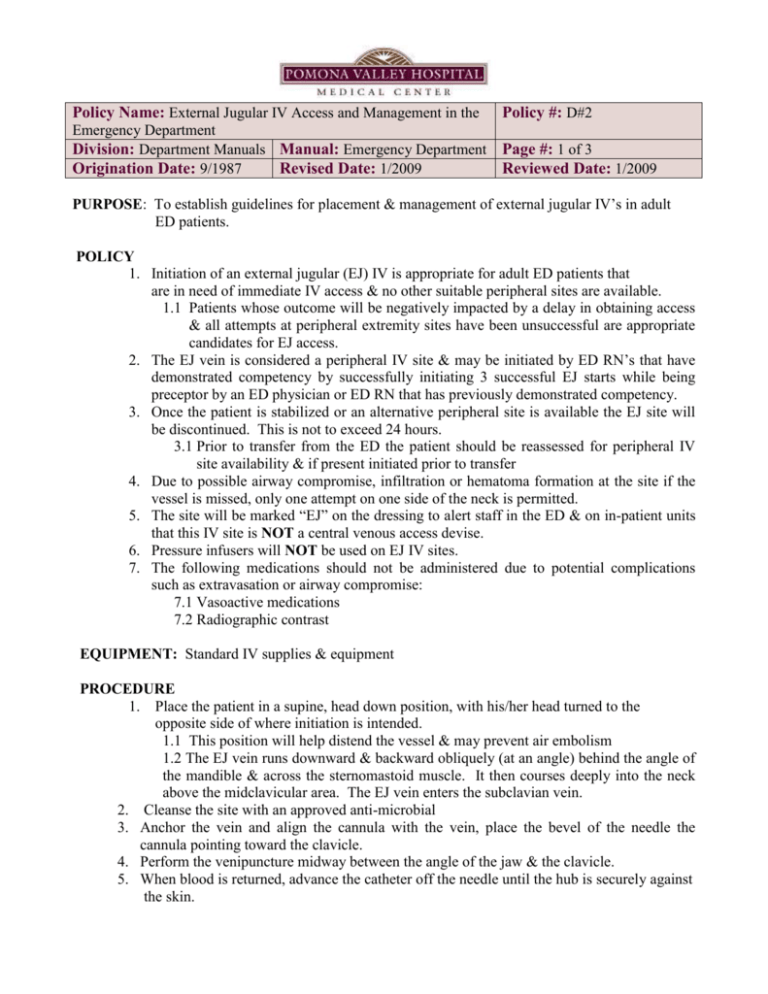
Policy Name: External Jugular IV Access and Management in the Policy #: D#2 Emergency Department Division: Department Manuals Manual: Emergency Department Origination Date: 9/1987 Revised Date: 1/2009 Page #: 1 of 3 Reviewed Date: 1/2009 PURPOSE: To establish guidelines for placement & management of external jugular IV’s in adult ED patients. POLICY 1. Initiation of an external jugular (EJ) IV is appropriate for adult ED patients that are in need of immediate IV access & no other suitable peripheral sites are available. 1.1 Patients whose outcome will be negatively impacted by a delay in obtaining access & all attempts at peripheral extremity sites have been unsuccessful are appropriate candidates for EJ access. 2. The EJ vein is considered a peripheral IV site & may be initiated by ED RN’s that have demonstrated competency by successfully initiating 3 successful EJ starts while being preceptor by an ED physician or ED RN that has previously demonstrated competency. 3. Once the patient is stabilized or an alternative peripheral site is available the EJ site will be discontinued. This is not to exceed 24 hours. 3.1 Prior to transfer from the ED the patient should be reassessed for peripheral IV site availability & if present initiated prior to transfer 4. Due to possible airway compromise, infiltration or hematoma formation at the site if the vessel is missed, only one attempt on one side of the neck is permitted. 5. The site will be marked “EJ” on the dressing to alert staff in the ED & on in-patient units that this IV site is NOT a central venous access devise. 6. Pressure infusers will NOT be used on EJ IV sites. 7. The following medications should not be administered due to potential complications such as extravasation or airway compromise: 7.1 Vasoactive medications 7.2 Radiographic contrast EQUIPMENT: Standard IV supplies & equipment PROCEDURE 1. Place the patient in a supine, head down position, with his/her head turned to the opposite side of where initiation is intended. 1.1 This position will help distend the vessel & may prevent air embolism 1.2 The EJ vein runs downward & backward obliquely (at an angle) behind the angle of the mandible & across the sternomastoid muscle. It then courses deeply into the neck above the midclavicular area. The EJ vein enters the subclavian vein. 2. Cleanse the site with an approved anti-microbial 3. Anchor the vein and align the cannula with the vein, place the bevel of the needle the cannula pointing toward the clavicle. 4. Perform the venipuncture midway between the angle of the jaw & the clavicle. 5. When blood is returned, advance the catheter off the needle until the hub is securely against the skin. Policy Name: External Jugular IV Access and Management in the Page #: 2 of 3 Emergency Department 6. Once the EJ site has been initiated; 6.1 Apply a transparent dressing over the insertion site 6.2 Stabilize the access device & tubing securely with tape to prevent dislodgement 6.3 Label the dressing with “EJ” in large letters, date & time of insertion, size of catheter & initials. 7. Site care is as is required for any peripheral IV site 8. Frequently evaluate the EJ site for signs of infiltration & discontinue fluid immediately if signs are present. 8.1 Extravasations of fluids &/or vasoactive medications into the neck is a serious complication, thus diligent monitoring of the site & documentation of patency is required. 9. Monitor frequently for signs of: 9.1 Infection 9.2 Pulmonary embolism 9.2.1 Dyspnea 9.2.2 Sudden onset of pleurtic pain 9.2.3 Tachypnea & tachycardia 10. Document the following information: 10.1 Site of insertion 10.2 Date & time of insertion 10.3 Catheter size 10.4 Patient response to procedure 10.5 Complications such as hematoma, signs of infection, signs of pulmonary embolism & signs of infiltration & extravasation 11. Educate the patient/family regarding excessive head movement & to report any pain, shortness of breath, bleeding or dampness at insertion site immediately CONTRAINDICATIONS 1. Initiation of an EJ is contraindicated in patients with cervical spinal injury, penetrating injury to neck, significant blunt trauma to the neck &/or soft tissue injury to the neck. 2. EJ access should be used with caution in patient’s than cannot tolerate a head down or supine position & when the anatomy of the EJ vein is not clearly discernable. 3. Clinical and/or physical limitations that would not allow proper securing of the EJ access, such as a large neck/no neck, diaphoresis, etc… Securing an EJ can be can be difficult, which increases the risk of accidental dislodgement as well as other complications. COMPLICATIONS & MANAGEMENT 1. Infection 2. Phlebitis 3. Hematoma formation at insertion site, which may cause airway compromise 3.1 Patients receiving anticoagulation therapy are at increased risk for hematoma at the insertion site 4. Accidental arterial puncture 5. Catheter shear, which may place the patient at risk for embolus formation 6. Air embolism may result from insertion or if the cap becomes dislodged: 6.1 Place the patient in a supine, head down position anytime the tubing becomes disconnected Policy Name: External Jugular IV Access and Management in the Page #: 3 of 3 Emergency Department Turn the patient’s head to the affected side Cleanse access devise with approved antimicrobial Apply a new needle less infusion cap Monitor the patient for signs of respiratory distress Apply a pressure dressing to the site 7. Monitor the patient for bleeding Accidental dislodgement 7.1 Apply firm pressure to the insertion site to control bleeding for at least 5 minutes. Be careful not to occlude arterial blood flow 6.2 6.3 6.4 6.5 REFERENCES: Fultz, J. & Sturt, P.A. (2005). Mosby’s Emergency Nursing Reference (3rd. ed), Philadelphia: Mosby. Reichman, E.F. & Simon, R.R. (2004). McGraw-Hill: New York Emergency Medicine Procedures. Approved by the ED Committee: September 2004
